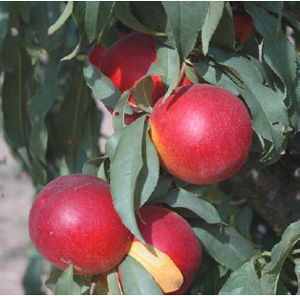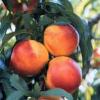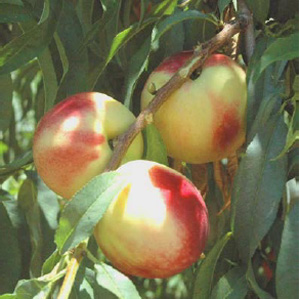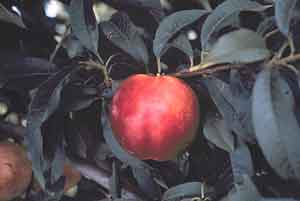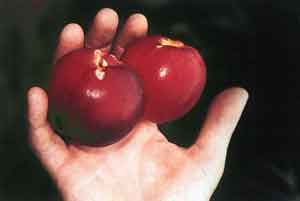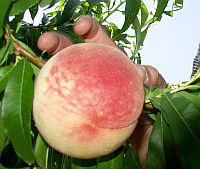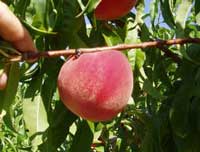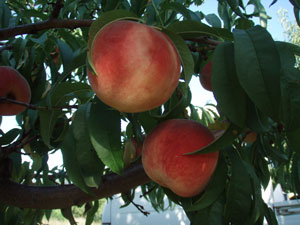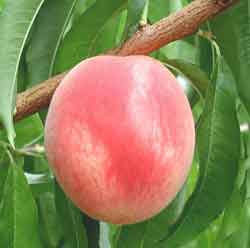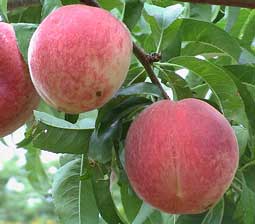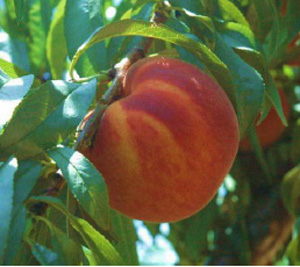Contact
Amanda McWhirt
Extension Fruit & Nut Specialist
Phone: 501-671-2229
Fax: 501-671-2252
Email: amcwhirt@uada.edu
Office:
University of Arkansas
Dept. of Horticulture
310 Plant Sciences Building
Fayetteville, AR 72701
Peaches and Nectarines
Peaches have long been a favorite of Arkansans, and peach production has been one of the major fruit crops in the State for many years. This production has included fresh market and processing types. Ripe peaches are generally considered hard to beat by most fruit consumers. Nectarine production and consumption in Arkansas has been much more limited, but has increased in the last 20 years as familiarity with this excellent crop has increased.
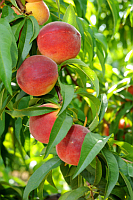
"What is the difference between a peach and a nectarine?"
Because nectarines have smooth skin like a plum, some people think they are a cross between a peach and a plum. But they are not! Nectarines are actually a genetic mutation of a peach. A nectarine is just a peach with smooth skin instead of one with fuzzy skin. Otherwise, they are very similar in most other characteristics, and are in the same genus and species, Prunus persica. Slight differences in flavor and brown rot susceptibility exist also. Otherwise they are produced the same culturally.
"What are the production limitations?"
Peach and nectarine production has several limitations for commercial producers and is especially limited for home producers. The first limitation is crop reduction from spring frosts which have been common in the last 15-20 years in Arkansas. Secondly, pest control is critical, as peaches and nectarines are very susceptible to numerous insects and diseases. Critical diseases include brown rot, peach scab and bacterial spot, and major insects are oriental fruit moth and peach tree borer. Thus spraying with fungicides and insecticides is required to produce a crop in most years. If no spraying is intended, then it is best to not consider these crops for production.
The University of Arkansas has been developing peach and nectarine cultivars since the late 1960s, and several cultivars have been released. This developmental work was done at the Fruit Research Station at Clarksville, so all dates of bloom or harvest are based on data collected at that location. The University of Arkansas patented nectarine and fresh-market peach cultivars are available from licensed fruit propagators.
| Home Garden Nectarine & Peach Tree Production website Cooperative Extension Service | Division of Agriculture | University of Arkansas System |
|
| Southeastern Peach, Nectarine and Plum Pest Management and Culture Guide |
Nectarine Cultivars - University of Arkansas Patented
Fresh-Market Peach Cultivars - University of Arkansas Patented
Processing Cling Peaches - University of Arkansas Developed
These peach cultivars released by the University of Arkansas are not patented and nursery lists are not maintained for them.
| AllGold Year released - 1984 Full Bloom Date - March 23 Maturity Date - July 1 Average Fruit Weight (g) - 205 Soluble Solids (percent sweetness) - 12.1 Bacterial Spot - 9 Rating - Flesh Color Rating - 8 Rating - Fruit Firmness - 8 |
Goldnine |
|
Goldilocks |
Roygold |
|
GoldJim |
|
|
Bacterial spot, flesh color and fruit firmness ratings based on a scale of 1-10 with
10 best. • Bacterial spot rating of 10 indicates no evidence of this disease in any years, with a rating of 7 a common commercial variety rating; • Flesh color rating is highest if flesh is fully golden-yellow and lacks red pigment in the flesh; • Fruit firmness rating higher for firmer fruit. |
|
